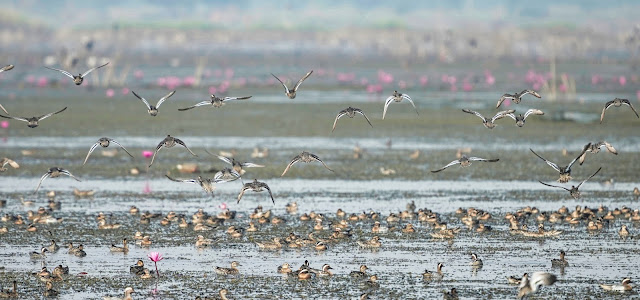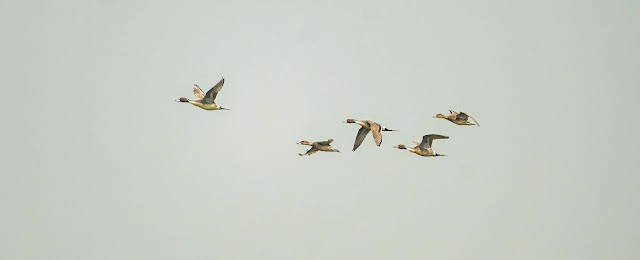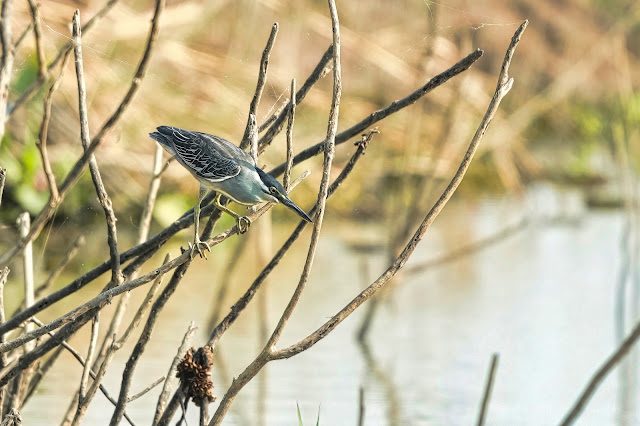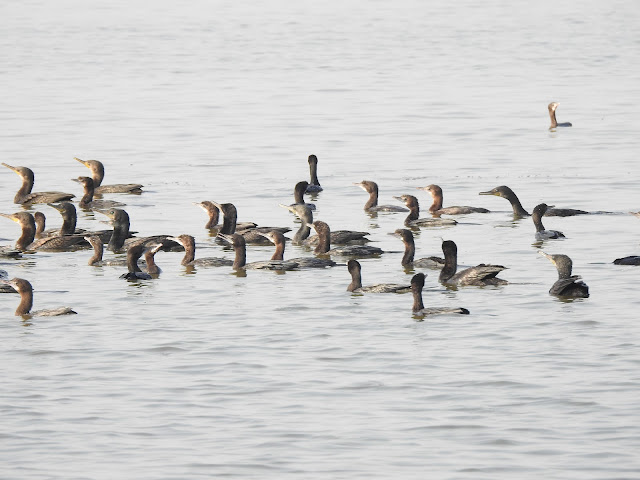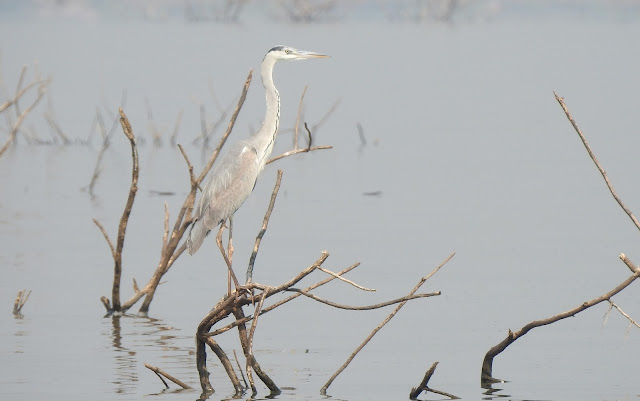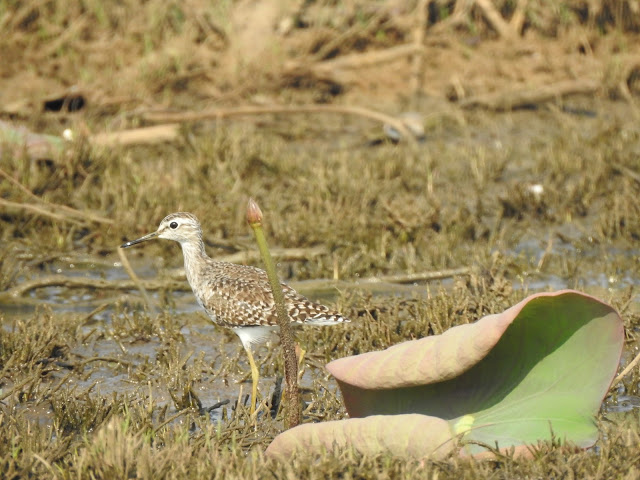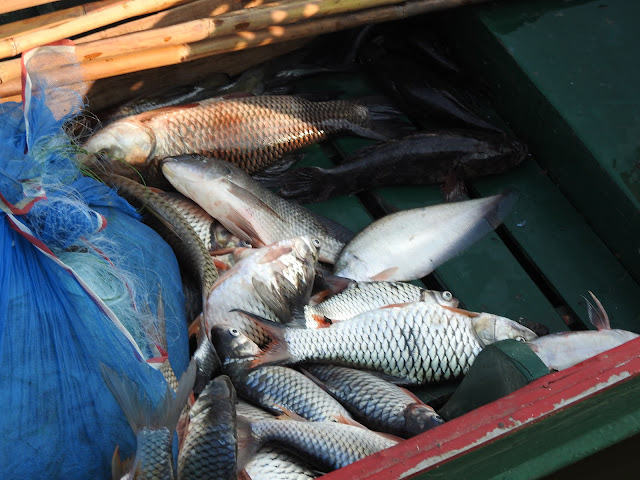Today was largely a travel day with some six hours in the vehicle all told. In between times we had regular toilet stops, the all important lunch, a hour or so birding stop at Klong Lan Waterfall, a brief but productive stop to twitch the Green Peafowl [the obvious bird of the day] before arriving at our accommodation - The Touchstar Resort - adjacent to the Doi Inthanon National Park.
Our first stop was the Khlong Lan Waterfall. The falls themselves are perhaps a kilometre or so walk from the main gate; along the road for much of it and then a boardwalk for the final 100 metres or so.
A decent hour birding produced a good mix of birds including Black Baza and Grey capped Pygmy Woodpecker - both new for the trip. Green eared and Lineated Barbets, a mix of bulbuls, drongos, flycatchers and warblers filled the remaining time.
Khlong Lan National Park (Thai อุทยานแห่งชาติคลองลาน) is a 300 km2 (120 sq mi) national park in Thailand.
Description - Khlong Lan National Park is situated in the Dawna Mountain Range.
This park lies in Khlong Lan and Mueang Kamphaeng Phet districts of Kamphaeng Phet Province, the Lower north of Thailand and occupies 187,500 rai ~ 300 square kilometres (120 sq mi).[2]
The park is rugged and hilly along the Dawna Range, and is covered by fertile forest. Each mountain connects to Khun Khlong Lan, the highest peak at 1,439 metres (4,721 ft) above sea level. It's the origin of Khlong Khlung and Khlong Suan Mak, the tributaries of the Ping River. The famous places in the park are Khlong Lan and Khlong Nam Lai Waterfalls.[3]
Bann Hong wild life reserve area was perhaps our main birding area to see Green Peafowl. This species is an incredibly striking bird; in my opinion more striking than the common and very well known Blue Peafowl of every movie set in India fame.
The green peafowl or Indonesian peafowl (Pavo muticus) is a peafowl species native to the tropical forests of Southeast Asia and Indochina. It is the national bird of Myanmar. Formerly common throughout Southeast Asia, only a few isolated populations survive within Cambodia (mainly in the northern and eastern provinces) and adjacent areas of Vietnam. It has been listed as endangered on the IUCN Red List since 2009, primarily due to widespread deforestation, agriculture and loss of suitable habitat, severely fragmenting the species' populations and contributing to an overall decline in numbers. Due to their natural beauty, they are still sometimes targeted by the pet trade, feather collectors, and even by hunters for meat. They are a much-desired bird for private and home aviculturists, despite their rather high-maintenance care requirements (when compared to the more common and hardy Indian blue peafowl).[1][2]
Unlike the related Indian peafowl, the sexes of green peafowl are quite similar in appearance, especially in the wild. Both males and females have long upper-tail coverts (which cover the tail itself, underneath). In the male, this extends up to 2 m (6.6 ft) and is decorated with eyespots; in the female, the coverts are green and much shorter, just covering the tail. Outside of the breeding season, however, the male's train is moulted; distinguishing the sexes during this period can be difficult unless they are observed quite up close. The neck and breast feathers (of both sexes) are highly iridescent green and resemble dragon scales. In the male, the scapular, median, and greater wing coverts are blue; the lesser coverts are green and form a triangle of scaly shoulder feathers (when the wing is closed). The secondaries are black and, in some subspecies, the tertials are brown and/or barred with a faint pattern. The female has blue lesser coverts, and lacks the triangle at the wing-shoulder. Females also have neck scales fringed with copper, as well as more barring on the back, the primaries and alula. Both sexes have shafted crests, are long-legged, heavy-winged, and long-tailed in silhouette. The crest of the female has slightly wider plumes, while those of the male are thinner but taller. The facial skin is double-striped with a whiteish-blue; beside the ear is a yellow-orange crescent. The dark triangle below the eye (towards the eyebrow) is bluish-green in the male, and brown in the female. Seen from a distance, they are generally dark-coloured birds with pale vermillion- or buff-coloured primaries, which are quite visible in their peculiar flight; this action has been described as a true "flapping" flight, lacking the gliding that one associates with many birds.
Green peafowl are generally more silent than Indian peafowl; the males will announce their presence, from their roost sites, at dawn and dusk.
The green peafowl was widely distributed in Southeast Asia in the past from southern China especially Yunnan, eastern and north-eastern India, southeastern Bangladesh, northern Myanmar, extending through Laos, and Thailand into Vietnam, Cambodia, Peninsular Malaysia, and the island of Java in Indonesia. Records from northeastern India have been questioned and old records are possibly of feral birds.[5] The ranges have reduced with habitat destruction and hunting.[3] [ Source - Wikipedia]










